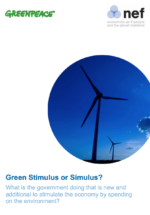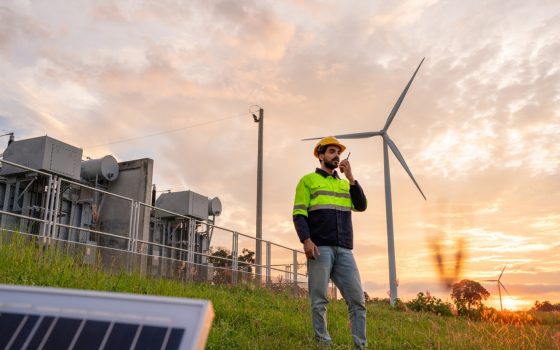Green Stimulus or Simulus?
What is the government doing that is new and additional to stimulate the economy by spending on the environment?
29 March 2009
Gordon Brown has claimed that around 10 per cent of the UK package to stimulate the economy was directed towards “environmentally important technologies”.
But as this NEF report commissioned by Greenpeace shows, new funding for greening the economy amounts to just 0.6 per cent of the UK’s total stimulus package.
The government could be missing a huge opportunity – the chance to boost the economy,
ensure energy security and act on climate change, by directing new and additional resources
into the environmental transformation of the economy.
In the context of the economic recession, the increasingly urgent challenge of climate change,
and calls for a Green New Deal, this report asks: what is the government doing that is new and
additional to stimulate the economy by spending on the environment?
The report reveals that:
- New and additional green spending included in the green stimulus package of the government’s Pre-Budget Report (PBR) is astonishingly small compared to other recent spending commitments, at just 0.6% of the UK’s £20bn recovery plan. This key element makes up just 0.0083% of UK GDP, but in the wake of the banking crisis nearly 20% of UK GDP has been provided to support the financial sector.
- New and additional green measures could save just 0.128 million tonnes of carbon dioxide (MtCO2) per year from the atmosphere and will only delay the accumulation of UK carbon emissions by six and a half hours by the end of 2011.
- Just over £100m is being allocated to spending that is genuinely new and additional; this is a fraction – less than 13% – of the annual bonus package given to staff at the failed Royal Bank of Scotland (RBS) which is estimated at approximately £775m. £100m represents just 0.0083% of UK GDP. Estimates for necessary new annual spending on environmental economic stimulus and transformation range from £11bn to £50bn.
- Figures from HSBC and the IMF indicate that among the major economies, the greater the proportion of GDP spent on bailing out banks coincides with a lower proportion spent on green stimuli.
- Several of the government’s measures are, in fact, in conflict with the environmenta stimulus. By comparison with the new and additional spending of the PBR’s green stimulus, £2.3bn – around 22 times – has been put aside to assist the car industry. If spent on energy efficiency measures this would save about 3 MtCO2 annually.
- £27m has been put aside specifically for development of a new Land Rover vehicle, the Land Rover Group are one of the most climate-unfriendly manufacturers in Europe. The potential CO2 savings of the proposed vehicle have not been specified. This is not encouraging, particularly given that this financial support is likely to delay a shift to greater use of public transport and that historically much of the gain in efficiency in vehicles has been negatively counter-balanced through a gain in weight of the vehicle concerned.
- There has been a further commitment to spend on building 520 lane miles of road expansion. Research indicates that the provision of new lanes leads to relative increases of between 30 and 50% in the number of vehicle miles travelled on that road – in other words, more car use. This happens due to the phenomenon known as induced traffic: building new roads merely encourages more traffic.
Topics Climate change Energy







